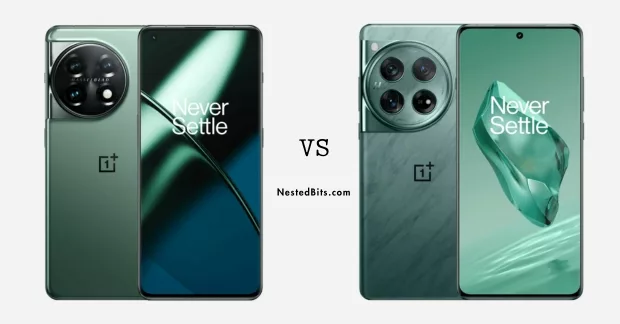When it comes to high-performance smartphones with sleek designs, one brand that consistently delivers is OnePlus. In this article, we’ll be comparing the features and specifications of two recent releases from the company – the OnePlus 11 and its successor, the OnePlus 12.
Let us start by taking a look at their design elements:
Both smartphones share similarities in terms of overall aesthetics with rounded edges and smooth curves that are characteristic of OnePlus devices. However, there is an exciting new addition to the OnePlus 12 – its unique Flowy Emerald finish, which sets it apart from its predecessor.
Moving on to display size, the OnePlus 12 boasts a larger 6.82-inch QHD+ AMOLED panel compared to the 6.75-inch FHD+ display of the OnePlus 11. Additionally, the newer model supports higher refresh rates – offering up to 120Hz ProXDR Display versus the older model’s standard 90Hz Fluid Display.
Underneath their elegant shells, both devices are packed with powerful processing units:
The OnePlus 11 comes equipped with Qualcomm Snapdragon 870 SoC, while its successor boasts an upgrade to the latest Snapdragon 8 Gen 3. Furthermore, RAM sizes have been bumped up in the newer model, offering users a choice between 12GB or even 16GB of LPDDR5X memory compared to the OnePlus 11’s maximum of 12GB.
As for storage capacities, both devices offer comparable options:
The OnePlus 12 provides up to 512GB UFS 4.0 internal storage, and the OnePlus 11 maxes out at 256GB UFS 3.1. However, it’s important to note that the newer model does not come with expandable microSD card slots for additional storage expansion like its predecessor.
Now let us discuss the camera:
The OnePlus 11 sports a versatile triple-camera setup consisting of a primary 48MP Sony IMX596 sensor, an ultra-wide-angle lens, and a telephoto lens with 3x optical zoom capabilities. In contrast, the OnePlus 12 introduces improvements such as a higher resolution main camera (50 MP) using Samsung’s LTB-808 primary sensor paired with a more advanced Hasselblad Camera System featuring a triple setup of a 64MP telephoto lens and an ultra-wide angle lens, along with a new 114° ultra-wide camera.
When it comes to battery life, the OnePlus 12 offers users an impressive upgrade:
Its massive dual-cell 5,400mAh capacity compared to the smaller 4,500mAh one found in the OnePlus 11. Both phones support fast charging with wired (80W vs. 65T Fast Charging) and wireless (50W AirVOOC vs. Warp Charge 30 Wireless Charging) capabilities.
In terms of price, while both devices deliver flagship-level performance, the OnePlus 12 comes with a slightly higher asking price of INR64,999 compared to its predecessor’s starting price point of around INR58,000 for its base variant back when it was released. This increase can be attributed to several factors such as upgraded hardware components and improved features like the Hasselblad Camera System, a larger battery capacity, and an enhanced display with higher refresh rates.
In conclusion, while both devices share similar design elements that are synonymous with OnePlus, there is no denying that the newer release – the OnePlus 12 – packs quite a punch when it comes to upgrades in terms of display size and refresh rate, camera hardware improvements, increased processing power, battery capacity, software enhancements, as well as price point. For those seeking top-notch performance with the latest technology integrated into their smartphone experience, the OnePlus 12 is undoubtedly worth considering as an upgrade from its predecessor – the OnePlus 11.



























